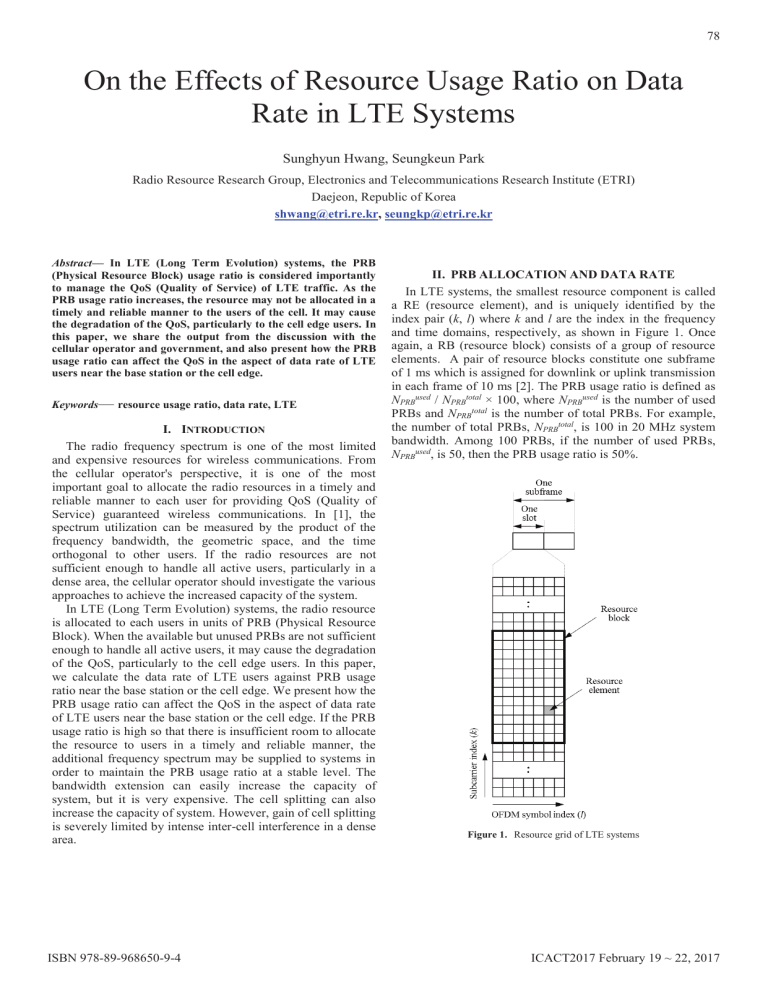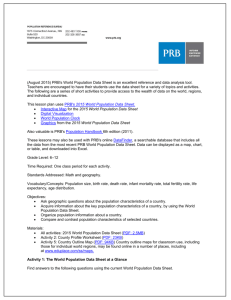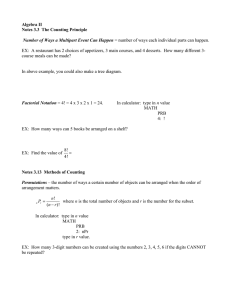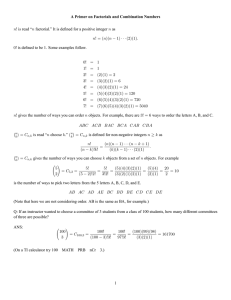
78 On the Effects of Resource Usage Ratio on Data Rate in LTE Systems Sunghyun Hwang, Seungkeun Park Radio Resource Research Group, Electronics and Telecommunications Research Institute (ETRI) Daejeon, Republic of Korea shwang@etri.re.kr, seungkp@etri.re.kr Abstract— In LTE (Long Term Evolution) systems, the PRB (Physical Resource Block) usage ratio is considered importantly to manage the QoS (Quality of Service) of LTE traffic. As the PRB usage ratio increases, the resource may not be allocated in a timely and reliable manner to the users of the cell. It may cause the degradation of the QoS, particularly to the cell edge users. In this paper, we share the output from the discussion with the cellular operator and government, and also present how the PRB usage ratio can affect the QoS in the aspect of data rate of LTE users near the base station or the cell edge. Keywords— resource usage ratio, data rate, LTE I. INTRODUCTION The radio frequency spectrum is one of the most limited and expensive resources for wireless communications. From the cellular operator's perspective, it is one of the most important goal to allocate the radio resources in a timely and reliable manner to each user for providing QoS (Quality of Service) guaranteed wireless communications. In [1], the spectrum utilization can be measured by the product of the frequency bandwidth, the geometric space, and the time orthogonal to other users. If the radio resources are not sufficient enough to handle all active users, particularly in a dense area, the cellular operator should investigate the various approaches to achieve the increased capacity of the system. In LTE (Long Term Evolution) systems, the radio resource is allocated to each users in units of PRB (Physical Resource Block). When the available but unused PRBs are not sufficient enough to handle all active users, it may cause the degradation of the QoS, particularly to the cell edge users. In this paper, we calculate the data rate of LTE users against PRB usage ratio near the base station or the cell edge. We present how the PRB usage ratio can affect the QoS in the aspect of data rate of LTE users near the base station or the cell edge. If the PRB usage ratio is high so that there is insufficient room to allocate the resource to users in a timely and reliable manner, the additional frequency spectrum may be supplied to systems in order to maintain the PRB usage ratio at a stable level. The bandwidth extension can easily increase the capacity of system, but it is very expensive. The cell splitting can also increase the capacity of system. However, gain of cell splitting is severely limited by intense inter-cell interference in a dense area. ISBN 978-89-968650-9-4 II. PRB ALLOCATION AND DATA RATE In LTE systems, the smallest resource component is called a RE (resource element), and is uniquely identified by the index pair (k, l) where k and l are the index in the frequency and time domains, respectively, as shown in Figure 1. Once again, a RB (resource block) consists of a group of resource elements. A pair of resource blocks constitute one subframe of 1 ms which is assigned for downlink or uplink transmission in each frame of 10 ms [2]. The PRB usage ratio is defined as NPRBused / NPRBtotal × 100, where NPRBused is the number of used PRBs and NPRBtotal is the number of total PRBs. For example, the number of total PRBs, NPRBtotal, is 100 in 20 MHz system bandwidth. Among 100 PRBs, if the number of used PRBs, NPRBused, is 50, then the PRB usage ratio is 50%. Figure 1. Resource grid of LTE systems ICACT2017 February 19 ~ 22, 2017 79 The data rate of LTE systems is determined by the MCS (Modulation and Coding Scheme) index and the number of used PRBs [3]. The MCS index can be determined using a CQI (channel quality indicator) metric which are periodically sent by the receivers via a feedback channel. Figure 2 shows the CQI value corresponding to the distance from the base station. The CQI is a function of SINR (Signal to Interference plus Noise Ratio) at a receiver. The closer the mobile station to the base station, the larger the CQI value. Each CQI value can be mapped into one MCS index such that the maximum data rate can be achieved. Figure 2. CQI value corresponding to distance from base station III. NUMERICAL RESULTS To evaluate the effects of PRB usage ratio on data rate, we calculate the data rate against MCS index with different PRB usage ratio. Here it is assumed that the channel bandwidth is 20 MHz over a SISO (Single Input Single Output) system, and that the unused PRBs are allocated to one user. Figure 3 shows the peak data rate against MCS index with different PRB usage ratio. As the PRB usage ratio increases, the peak data rate with MCS index of 28 decreases sharply. For example, as the PRB usage ratio increase from 10% to 70% and from 50% to 70%, the peak data rate decreases from 66.59 Mbps to 22.15 Mbps and from 36.7 Mbps to 22.15 Mbps, respectively. These are equivalent to the data rate loss of 67% and 40%, respectively. On the other hand, Figure 4 shows the cell edge data rate against MCS index with different PRB usage ratio. As the PRB usage ratio increases, the cell edge data rate decreases so that it is too low to meet the minimum requirement of QoS. To support the streaming services, the system generally requires the data rate of at least 2 Mbps. When the PRB usage ratio reaches 70%, the data rates with the MCS index below 3 is insufficient to support the minimum requirement of 2 Mbps. Figure 3. Peak data rate against MCS index with different PRB usage ratio Figure 4. Cell edge data rate against MCS index with different PRB usage ratio Figure 5 shows the average data rate near the base station against PRB usage ratio. The high MCS indices are generally used near the base station. For example, when the MCS indices larger than 25 are used, as the PRB usage ratio increase from 10% to 70% and from 50% to 70%, the average data rate near the base station decreases from 57.5 Mbps to 19.39 Mbps and from 31.82 Mbps to 19.39 Mbps, respectively. These are equivalent to the data rate loss of 66% and 39%, respectively. On the other hand, Figure 6 shows the average data rate near the cell edge against PRB usage ratio. The robust MCS indices are generally used near the cell edge. When the PRB usage ratio is larger than 70%, the average data rate near the cell edge are going down to about 2 Mbps and less, which is insufficient to support the minimum requirement of QoS. Figure 5. Average data rate near base station against PRB usage ratio ISBN 978-89-968650-9-4 ICACT2017 February 19 ~ 22, 2017 80 As the PRB usage ratio increases, the resource may not be allocated in a timely and reliable manner to the users of the cell. It may cause the degradation of the QoS, particularly to the cell edge users. In this paper, we present how the PRB usage ratio can affect the QoS in the aspect of data rate of LTE users near the base station or the cell edge. As the PRB usage ratio increase from 10% to 70% and from 50% to 70%, the peak data rate decreases from 66.59 Mbps to 22.15 Mbps and from 36.7 Mbps to 22.15 Mbps, respectively. These are equivalent to the data rate loss of 67% and 40%, respectively. Moreover, when the PRB usage ratio is larger than 70%, the average data rate near the cell edge are going down to about 2 Mbps and less, which is insufficient to support the minimum requirement of QoS. According to the numerical results, we come to the conclusion that the wireless communication system should maintain a stable PRB usage ratio to meet the QoS requirements, particularly to the cell edge users. Figure 6. Average data rate near cell edge against PRB usage ratio From the numerical results above, it is observed that increase of the PRB usage ratio causes decrease of data rate in LTE networks. Thus the resource may not be allocated in a timely and reliable manner to the users in a dense area. It may lead to the degradation of the QoS, particularly to the cell edge users. The capacity of the system can be increased by using various methods. To increase the system capacity, the additional radio frequency spectrums can be supplied using bandwidth extension, dynamic TDD (Time Division Duplex), etc. In terms of space domain, the system capacity can be increased by using multiple antennas, cell splitting, etc. The system capacity can also be improved by enhancing the spectral efficiency with higher order modulation, NOFDM (Non-Orthogonal Frequency Division Multiplexing), etc. Here it is assumed that the unused PRBs are allocated to one user and that the single antenna and single bandwidth are used. If the conditions are complicated so that the unused PRBs are allocated to multiple users and that the MIMO (Multiple Input Multiple Output) and carrier aggregation are used, the PRB usage ratio may differently affect data rate. In [4], the bandwidth utilization of all network links should be maintained within 75% loading during peak hours on a monthly basis. If the bandwidth utilization surpasses the 90% loading level, the operator is required to immediately supply the additional bandwidth. Similarly the cellular operators should examine the effects of PRB usage ratio on QoS in various conditions, then the LTE system should maintain the PRB usage ratio at a stable level. ACKNOWLEDGMENT This work was supported by the ICT R&D programs of MSIP/IITP, Republic of Korea. [B0717-17-0059, Development of coexistence technology and analysis tool for the promotion of free band/unlicensed band, B0101-16-0222, Development of Core Technology to Improve Spectral Efficiency for Mobile Big-Bang] REFERENCES [1] [2] [3] [4] ITU-R SM.1046-2, Definition of spectrum use and efficiency of a radio system, May 2006. 3GPP TS 36.211, Evolved Universal Terrestrial Radio Access (EUTRA); Physical Channels and Modulation (Release 11), February 2013. 3GPP TS 36.213, Evolved Universal Terrestrial Radio Access (EUTRA); Physical layer procedures (Release 12), June 2015. iDA, Review of Quality of Service Framework for Broadband Access Services, August 2000. Sunghyun Hwang received his B.S., M.S., and Ph.D. degrees in electrical engineering from Sungkyunkwan university in 1996, 1998, and 2001, respectively. He is currently a principal researcher at Electronics and Telecommunications Research Institute (ETRI). His research interests include signal processing for wireless communications, with focus on multicarrier transmission and spectrum sharing. Seungkeun Park received his B.S. and M.S. degrees in applied statistics from Korea University, Seoul, Rep. of Korea, in 1991 and 1993, respectively. He received his Ph.D. degree in information communication engineering from the University of Chungbuk, Cheongju, Rep. of Korea, in 2004. He is currently a researcher at Electronics and principal Telecommunications Research Institute (ETRI). His research interests include statistical communication and electromagnetic theories. IV. CONCLUSIONS ISBN 978-89-968650-9-4 ICACT2017 February 19 ~ 22, 2017



